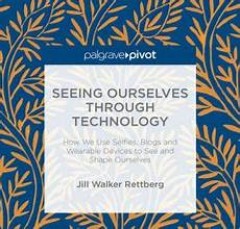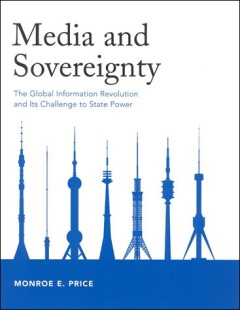Filter by

Transmedial Narration : Narratives and Stories in Different Media
This open access book is a methodical treatise on narration in different types of media. A theoretical rather than a historical study, Transmedial Narration is relevant for an understanding of narration in all times, including our own. By reconstructing the theoretical framework of transmedial narration, this book enables the inclusion of all kinds of communicative media forms on their own term…
- Edition
- 1
- ISBN/ISSN
- 9783030012946
- Collation
- VIII, 152 hlm,: ill, lamp;
- Series Title
- -
- Call Number
- -

Seeing Ourselves Through Technology
This book is open access under a CC BY license. Selfies, blogs and lifelogging devices help us understand ourselves, building on long histories of written, visual and quantitative modes of self-representations. This book uses examples to explore the balance between using technology to see ourselves and allowing our machines to tell us who we are.
- Edition
- 1
- ISBN/ISSN
- 978-1-137-47666-1
- Collation
- -
- Series Title
- -
- Call Number
- Palgrave Macmillan London

Tech giants, artificial intelligence, and the future of journalism
- Edition
- -
- ISBN/ISSN
- 9781351013758
- Collation
- -
- Series Title
- -
- Call Number
- -
- Edition
- -
- ISBN/ISSN
- 9781351013758
- Collation
- -
- Series Title
- -
- Call Number
- -

State-sponsored disinformation around the globe: how politicians deceive thei…
Introduction : deceiving from the top : state-sponsored disinformation as a contemporary global phenomenon / Martin Echeverría and Sara García Santamaría -- Theoretical understanding of state-sponsored disinformation / Petros Iosifidis -- Rethinking disinformation for the global South : towards a particular research agenda / Grisel Salazar Rebolledo -- Statistics and state-sponsored disin…
- Edition
- -
- ISBN/ISSN
- 9781032632940
- Collation
- -
- Series Title
- -
- Call Number
- -

Innovations in journalism :comparative research in five European Countries
- Edition
- -
- ISBN/ISSN
- 9781032630410
- Collation
- -
- Series Title
- -
- Call Number
- -
- Edition
- -
- ISBN/ISSN
- 9781032630410
- Collation
- -
- Series Title
- -
- Call Number
- -

SOCIAL MEDIA AND DIGITAL POLITICS: networked reason in an age of digital emotion
- Edition
- -
- ISBN/ISSN
- 9781003386377
- Collation
- -
- Series Title
- -
- Call Number
- -
- Edition
- -
- ISBN/ISSN
- 9781003386377
- Collation
- -
- Series Title
- -
- Call Number
- -

Das Formular
Wenn stimmt, was bereits Friedrich Schiller beklagt hat: dass der Mensch in der modernen Gesellschaft „zum Formular geworden“ ist, dann steht mit diesem unscheinbaren Verwaltungs-tool nichts weniger als unsere Lebenswirklichkeit auf dem Spiel. Der erste (Open Access-)Band der Reihe AdminiStudies beschäftigt sich deshalb mit der Funktion und Geschichte von Formularen, jenen institutionalisi…
- Edition
- 1
- ISBN/ISSN
- -
- Collation
- -
- Series Title
- AdminiStudies. Formen und Medien der Verwaltung
- Call Number
- XIII, 324

The Science of Citizen Science
This open access book discusses how the involvement of citizens into scientific endeavors is expected to contribute to solve the big challenges of our time, such as climate change and the loss of biodiversity, growing inequalities within and between societies, and the sustainability turn. The field of citizen science has been growing in recent decades. Many different stakeholders from scientist…
- Edition
- -
- ISBN/ISSN
- 978-3-030-58278-4
- Collation
- -
- Series Title
- -
- Call Number
- -

Entertainment-Education Behind the Scenes: Case Studies for Theory and Practice
This Open Access book tracks the latest trends in the theory, research, and practice of entertainment-education, the field of communication that incorporates social change messaging into entertaining media. Sometimes called edutainment, social impact television, narrative persuasion, or cultural strategy, this approach to social and behavior change communication offers new opportunities includi…
- Edition
- -
- ISBN/ISSN
- 978-3-030-63614-2
- Collation
- -
- Series Title
- -
- Call Number
- -

Media and sovereignty :
Media have been central to government efforts to reinforce sovereignty and define national identity, but globalization is fundamentally altering media practices, institutions, and content. More than the activities of large conglomerates, globalization entails competition among states as well as private entities to dominate the world's consciousness. Changes in formal and informal rules, in addi…
- Edition
- -
- ISBN/ISSN
- 9780262281904
- Collation
- -
- Series Title
- -
- Call Number
- -
 Computer Science, Information & General Works
Computer Science, Information & General Works  Philosophy & Psychology
Philosophy & Psychology  Religion
Religion  Social Sciences
Social Sciences  Language
Language  Pure Science
Pure Science  Applied Sciences
Applied Sciences  Art & Recreation
Art & Recreation  Literature
Literature  History & Geography
History & Geography